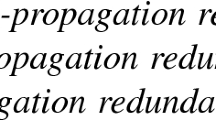Abstract
In this paper, we propose different new techniques for introducing additional clauses in a rather restricted way. Most of the new techniques are based on the introduction of a formula C → C and a simple decomposition technique. In order to restrict the introduction of such formulae, we choose C from redundant clauses like clauses C ∀ L with a pure literal L which are derived in the deduction. We prove the correctness of these techniques and introduce a class of propositional formulae for which any resolution refutation has length super-polynomially related to the length of the input formula. We demonstrate how a super-polynomial decrease of proof length can be achieved for these formulae by applying our new techniques in combination with resolution.
Preview
Unable to display preview. Download preview PDF.
Similar content being viewed by others
References
W. Bibel. Automated Theorem Proving. Vieweg, Braunschweig, second edition, 1987.
W. Bibel. Short Proofs of the Pigeonhole Formulas Based on the Connection Method. Journal of Automated Reasoning, 6:287–297, 1990.
R. Boyer. Locking: A Restriction of Resolution. PhD thesis, The University of Texas at Austin, 1971.
C. L. Chang and R. C. Lee. Symbolic Logic and Mechanical Theorem Proving. Academic Press, New York, 1973.
S. A. Cook. A Short Proof of the Pigeon Hole Principle Using Extended Resolution. SIGACT News, 1976.
M. Davis. Elimating the Irrelevant from Mechanical Proofs. Proc. Symp. Appl. Math., 15:15–30, 1963.
M. Davis and H. Putnam. A Computing Procedure for Quantification Theory. Journal of the ACM, 7(3):201–215, 1960.
E. Eder. An Implementation of a Theorem Prover Based on the Connection Method. In W. Bibel and B. Petkoff, editors, AIMSA 84, Artificial Intelligence — Methodology, Systems, Applications, Varna, Bulgaria, Amsterdam, September 1984. North-Holland.
U. Egly. A Simple Proof for the Pigeonhole Formulae. In B. Neumann, editor, Proceedings of the European Conference on Artificial Intelligence, pages 70–71. John Wiley & Sons, 1992.
A. Haken. The Intractability of Resolution. Journal of Theoretical Computer Science, 39:297–308, 1985.
B. Krishnamurthy. Short Proofs for Tricky Formulas. Acta Informatica, 22(3):253–275, Aug. 1985.
N. V. Murray and E. Rosenthal. Short Proofs of the Pigeonhole Formulas Using Path Dissolution. Technical report, Dept. of Computer Science, State Univ. of N.Y. at Albany, Albany N.Y. 12222, 1988.
D. A. Plaisted and S. Greenbaum. A Structure-Preserving Clause Form Translation. Journal of Symbolic Computation, 2:293–304, 1986.
J. A. Robinson. A Machine-Oriented Logic Based on the Resolution Principle. Journal of the ACM, 12(1):23–41, Jan. 1965.
G. S. Tseitin. On the Complexity of Derivation in Prepositional Calculus. In A. O. Slisenko, editor, Studies in Constructive Mathematics and Mathematical Logic, Part II, pages 234–259. Seminars in Mathematics, V.A. Steklov Mathematical Institute, vol. 8, Leningrad, 1968. English translation: Consultants Bureau, New York, 1970, pp. 115–125.
Author information
Authors and Affiliations
Editor information
Rights and permissions
Copyright information
© 1995 Springer-Verlag Berlin Heidelberg
About this paper
Cite this paper
Egly, U. (1995). Super-polynomial speed-ups in proof length by new tautologies. In: Pinto-Ferreira, C., Mamede, N.J. (eds) Progress in Artificial Intelligence. EPIA 1995. Lecture Notes in Computer Science, vol 990. Springer, Berlin, Heidelberg. https://doi.org/10.1007/3-540-60428-6_3
Download citation
DOI: https://doi.org/10.1007/3-540-60428-6_3
Published:
Publisher Name: Springer, Berlin, Heidelberg
Print ISBN: 978-3-540-60428-0
Online ISBN: 978-3-540-45595-0
eBook Packages: Springer Book Archive




